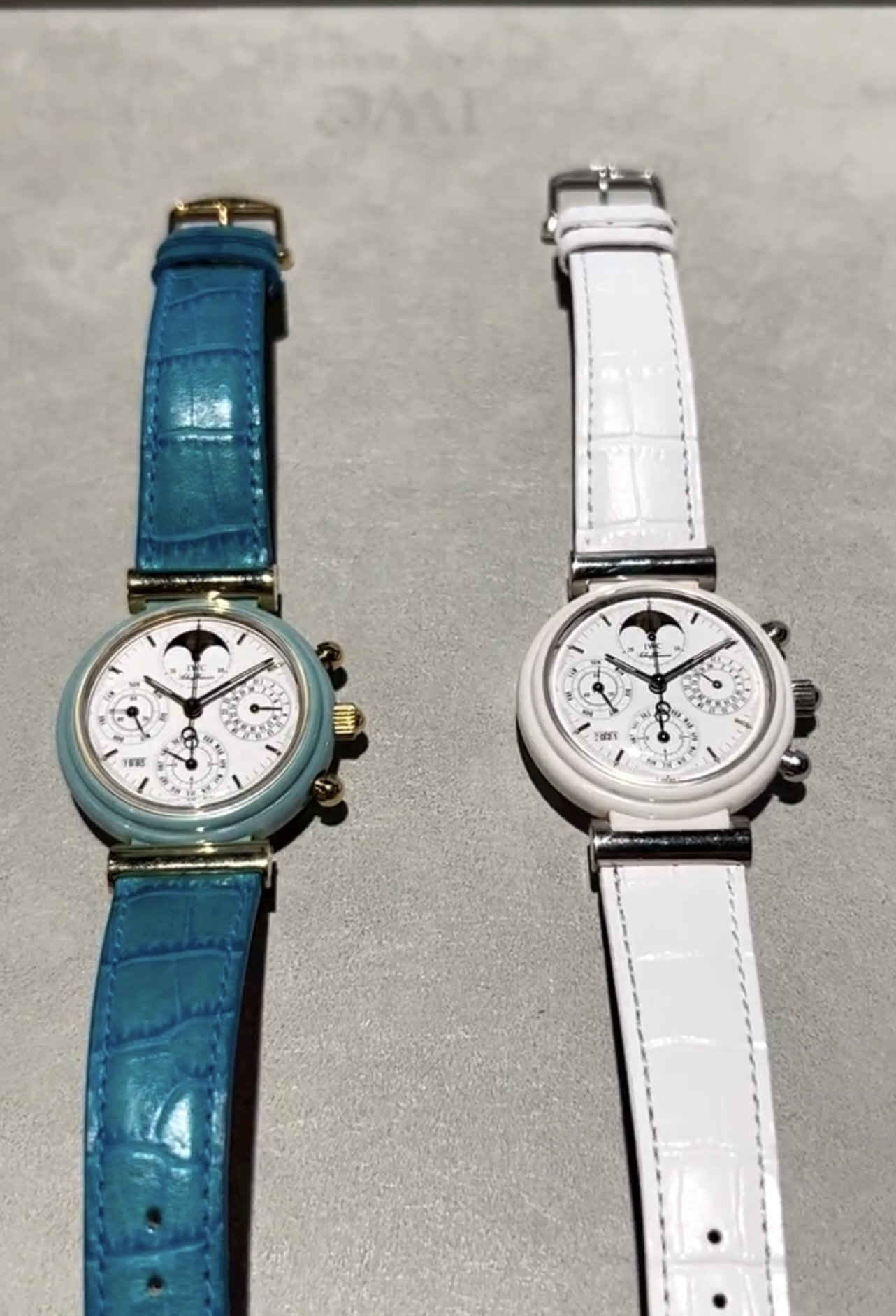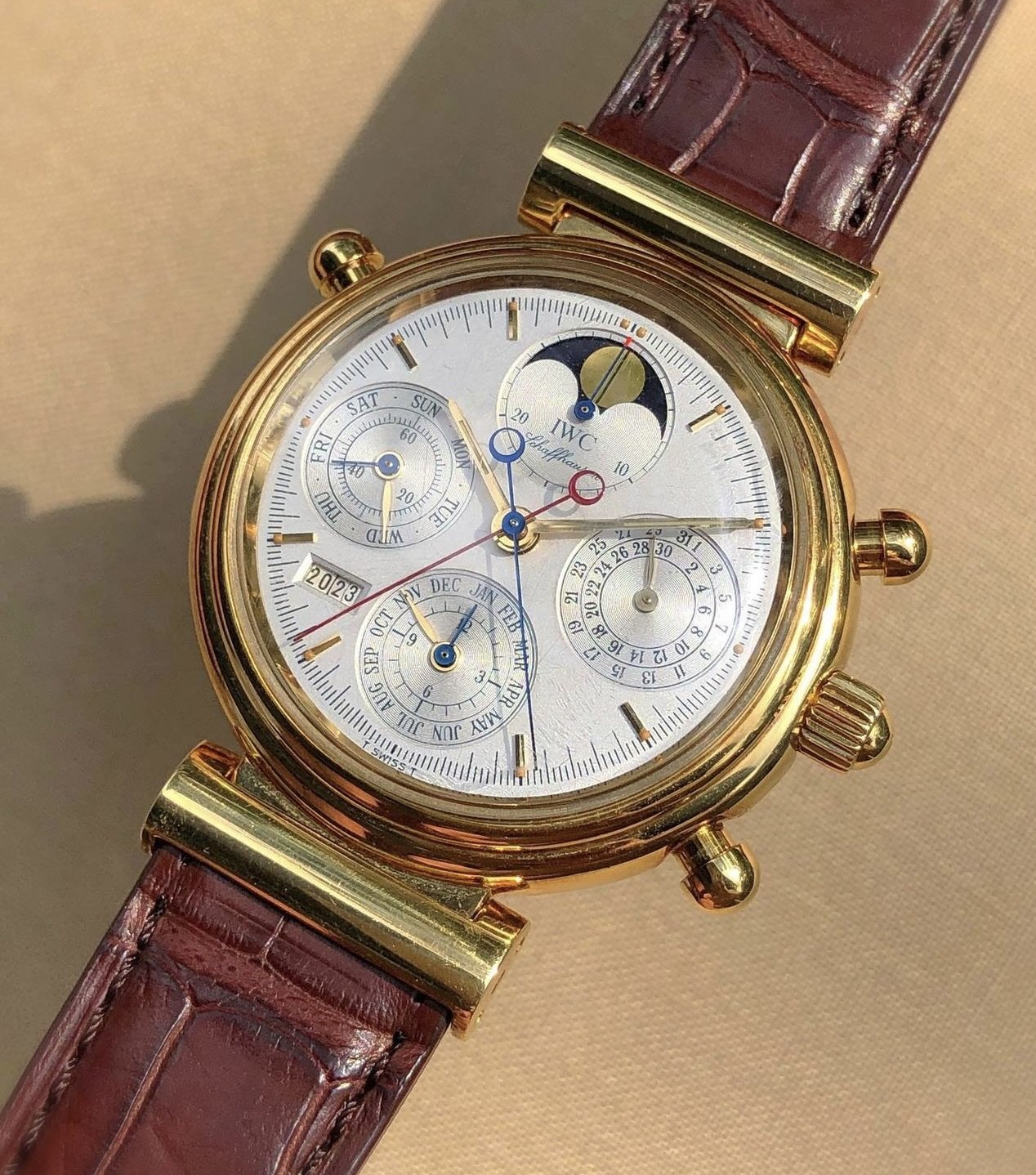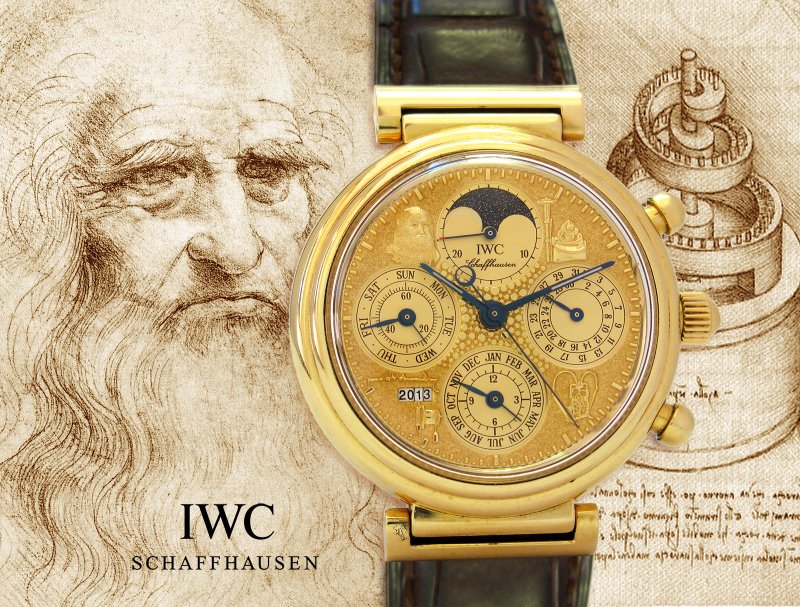Evolution of the IWC Da Vinci Perpetual Calendar Chronograph
As the current horological zeitgeist shifts to favor neo-vintage and lesser-known models from established watch brands, The International Watch Company, better known as IWC, has one of the most interesting and often overlooked creations—the IWC Da Vinci Perpetual Calendar Chronograph.
The Quartz Crisis Impact (Mid-20th Century)
The Quartz Crisis severely impacted the traditional watchmaking industry, causing the number of Swiss watchmakers to drop from 1,600 to 600. Despite the adversity, this period prompted innovation among the remaining watchmakers. As the “quartz crisis” ravaged Swiss watchmaking in the late 1970s, certain brands focused on creating truly magnificent creations.
Revival Led by Günter Blümlein and Kurt Klaus (Post-Quartz Crisis)
Kurt Klaus, Watch Mania
Günter Blümlein, as CEO of IWC at the time, along with Kurt Klaus, began an ambitious project to revitalize mechanical watchmaking. Kurt Klaus, a master watchmaker, undertook the development of a new kind of perpetual calendar. This innovation was based on a heavily modified Valjoux 7750, creating the calibre 79060 in the original Da Vinci. The movement was later improved and evolved into the calibre 79061 and then calibre 79261, which integrated a perpetual calendar module with just 81 parts, designed to function until the year 2499 without correction.
It cannot be understated just how revolutionary this movement was. To this point, no perpetual calendar modules were this thin, easy to use, easy to service, and affordable. A true feat especially considering the price of the movement and how reasonable the watch itself was and still is today.
1985 — Introduction of Da Vinci Perpetual Calendar and release of the Ref. 3750
IWC Magazine circa 1985, Introducing the Ref. 3750 via EuropaStar
Upon completion, the Da Vinci Ref. 3750 was released in 1985 at BaselWorld. The Da Vinci Perpetual Calendar featured a case inspired by Leonardo da Vinci’s designs (apparently). Hanno Burtscher, IWC’s designer, designed the case of the Da Vinci. There are different reports regarding how he was inspired. One report indicates that he looked at Leonardo Da Vinci’s sketches, including those showing fortifications in the Port of Piombino. Another report relayed that IWC had received in the early 1980s, a vintage IWC watch from Italy with articulated lugs that required service. According to one IWC executive, it was this model that inspired the design of the Da Vinci with special lugs. (IWC)
This timepiece, along with its complications like the day, date, month, leap year, and moon phase, could all be synchronized and advanced via the crown.
This in and of itself is an accomplishment worthy of praise as almost all perpetual calendars at the time required pushers to adjust the settings. However, it didn’t stop there as for the perpetual calendar module, Kurt Klaus needed fewer than 90 individual parts. Technically, the design was brilliant, “the fact that Klaus had also made the actual assembly of the movement an integral part of the design was nothing short of revolutionary.” (IWC)
Some people within the watch space theorize this IWC model is one of the main reasons IWC was able to survive the 1980s and prosper.
IWC ref. 3750, The Keystone
The IWC 3750 was available in many different configurations including special additions, some of which are below.
The base model was housed in an 18K yellow gold case with a white dial (as seen above). However, there was also a stainless steel version both with a white or black dial, a white gold case with a white dial, and a red (pink/rose) gold version with a black dial.
The stainless steel version was available on a bracelet and named under the same reference. “Ref. 3750-32”, 33, 34, and 35. This is unusual as all other models under the Da Vinci line that were available on bracelets, have their own separate reference numbers (for example, the classic Ref. 3750-03 on a bracelet would then be Ref. 9252-03)
Pricing
As for pricing, we can adjust the MSRP from 1995 to 1985 and estimate, as I was unable to find the original suggested retail price.
A rather poorly-aged ad from IWC featuring the MSRP for a stainless steel Ref. 3750
Based on this ad above, 12,500 USD in 1995 adjusted to 1985, comes to just under 9,000 USD back then. This would be very close (presumably) to the suggested retail price of the time you could expect to pay for the base model stainless steel version.
As times have clearly changed, you can pick up the same watch in stainless steel for a little over 6,000 USD if you’re patient. This one sold for 6,767 USD via LoupeThis on a bracelet.
A gold Ref. 3750 sold at Sotheby’s for just shy of 7,000 GBP in September of 2022.
According to my calculations after finding a line of best fit from the auction data available on Collector Square, an average of all price points comes to around 7,500 EUR. Adjust for inflation at 2.5% year after year, and you should have a good idea of what to spend on Ref. 3750.
Disclaimer: Because there are variations in metal and editions, this is just a guideline and estimate. Also, these are auction results. You can find this exact reference on sites like Chrono24 for even less. Example
Just for comparison's sake, you can buy a new Rolex Submariner (which features only a date and time function) for 9,100 USD at retail. Or you can purchase a Perpetual Calendar Chronograph in a precious metal.
Perhaps one of the best values you can get in watches currently.
1986 — First Commercial Production of Ceramic Watch Cases and Expansion into Colored Ceramics
Image courtesy of Europa Star, 1986
As a slight sidenote, at this time of innovation, IWC was also focused on unique materials for watch cases. One year after the release of the Ref. 3750, IWC pioneered the use of Zirconium oxide or ceramic for watch cases, notably scratch-resistant except by diamonds.
Da Vinci Ceramic Perpetual Calendar, 1986, Photograph courtesy of IWC Corporate Archives
Both turquoise and white ceramic, @iwcvintage
In 1986 they introduced various models of the base model Ref. 3750 in colored ceramic including black, white, and a rare turquoise prototype. These renditions are known as the Ref. 3755.
A special white ceramic with white gold pushers version was made for the Italian market, numbers produced are in the low twenties. These were available from 1986 to 1995. Less than 200 were made of black/charcoal ceramic, 20 were made in white, and one was made in turquoise. (According to Davidoff Brothers on Instagram)
1988 — Special Edition Ref. 3750-05 18K Rose Gold
Created in 1988 in rose gold with a very distinct black dial, this special edition Ref. 3750-05 comes in 18K rose gold, made only for the Italian market in celebration of 120 years of IWC, and limited to 120 pieces. Interestingly, IWC also produced the exact same watch without the case back engraving that stated it was limited, offered it on a bracelet too, and mass-produced it. It is unclear why they did that.
The special edition was Ref. 3750-05 and featured the engraving on the case back. The mass-produced version seemingly is the exact same watch sans inscription and went by Ref. 3750-23, 24, 25, and 26 (differentiating the market it was made for)
Ref. 9252, A Collected Man
All Da Vinci’s on bracelets had their own reference numbers as well, so this variation on the bracelet goes by Ref. 9252-09, 10, 11, and 12 indicating dial language). For the exhaustive list checkout WatchBase, incredible resource.
Ref. 3750, Special Edition caseback, Davidoff Brothers
Mass produced version without inscription, Chrono24
1995 — Release of Ref. 3751
News of the Ref. 3751 via Europastar
By 1995, IWC had solidified itself as a brand that was around to stay. For the tenth anniversary of the original Ref. 3750, a special Ref. 3751 was produced. Ref. 3751 featured a Rattrapante Chronograph, designed by Richard Habring (now of Habring²), a junior watchmaker at IWC.
An interesting bit of trivia is that IWC chose a rattrapante module for the 10th anniversary of the Da Vinci because adding an additional hand would put the total number of hands at 10 on the face of the watch.
Also, just like Kurt Klaus’s design of the base movement, Richard Habring’s contributions cannot be understated. When he was hired by IWC in 1990, he became a project leader and was tasked with creating a practical and cost-effective split-second module. Even today, a rattrapante module is one of the hardest complications to make. However, within 5 years, Habring had created one and it was then implemented into the Da Vinci, resulting in the Ref. 3751.
18K yellow gold ref. 3751, @horologically_unique
Platinum limited edition ref. 3751, @misterenthusiast
The 3751 Rattrapante was available widely in gold (see above ad) or limited to 500 in platinum. It was only available until the year 2000 when IWC changed the dial, substituted the plexiglass crystal for sapphire, and made the case 2.5 millimeters larger (Ref. 3754)
Ref. 3754 in a catalog from 2000 (the year it was released)
Ref. 3754, Antiquorum
Rewind… 1993 IWC's Grand Complications
The development of complications like the tourbillon, minute repeater, rattrapante, and perpetual calendar was also emphasized by IWC, culminating in the IWC “Il Destriero Scafusia” Grand Complication or “War Horse” being released in 1993.
Il Destriero Scafusia by IWC
While not technically built with the Da Vinci case, its creation is unlikely without the technical advancements of the Da Vinci Perpetual Calendars before it. The design aesthetics are also quite similar. Dominique Renaud and Giulio Papi, two grand complication watchmakers, were tasked with creating the minute repeating complication using the Da Vinci base. Since they couldn’t build the necessary strike train into the existing movement, they would create a module with all the repeater function to be sandwiched between the dial and the movement.
IWC proceeded to utilize some of these complications found in the Il Destriero Scafusia and incorporated them into special Da Vinci Perpetual Calendar Chronograph models.
1999 and beyond — Release of the Ref. 3752, and other Special Additions
In the late 1990s, IWC proceeded to add a tourbillion to the base Ref. 3750. The Da Vinci Tourbillon Ref. 3752, was unveiled in 1999, and limited to 50 in platinum and 200 in yellow gold, the Da Vinci Tourbillon was essentially indistinguishable from the base-model Da Vinci, with the only giveaway being “Tourbillon” in between four and five o’clock. Like the rattrapante, Richard Habring designed the Ref. 3752 as well.
All platinum tourbillon models were characterized by a unique blue dial, while the gold tourbillons shared the quintessential white color scheme dial as seen on Ref. 3570.
Ref. 3752 Platinum Perpetual Calendar Tourbillon, @lunaroyster
Even shortly after releasing the first Ref. 3750 in 1985, IWC was no stranger to creating special editions or adding complications to the Da Vincis. Almost all of these special editions are categorized by their own reference numbers and include everything from fully paved dials, diamond set cases, special case and dial materials, etc.
Models with gem-set cases carry the reference 8153. A bracelet option was offered in the form of the reference 9252, or 9253 if the case was to be set with diamonds. Its successor, the 3758, was introduced in 2005.
The first versions used the caliber 7906(0) movement, which was updated to 79061 around 1988 and finally 79261 around 1995.
‘Four Seasons’, SJX
In 1999, IWC also released a special edition tourbillon version called the “Four Seasons” or Quattro Stagioni which featured an immaculate hand-carved dial by Wolfgang Siegwart, the former chief engraver at IWC.
The inspiration for the watch came from a customized Da Vinci made in the early 1990s for a European client, whose timepiece featured an engraved gold dial. That one-off watch formed the genesis of the Four Seasons.
Another special edition tourbillon model was the “Leonardo” in 2002. 150 pieces of the Da Vinci Tourbillon Leonardo were produced, with 50 in each color of gold. Made to mark the 550th anniversary of Leonardo Da Vinci’s birth, the Tourbillon Leonardo featured a bust of the artist and his inventions on the dial.
This particular example, the Ref. 9253, is a special Gem-Set reference for the Ref. 3750 Da Vinci that also comes with a solid-gold bead-of-rice IWC bracelet. It features 149 diamonds and 12 rubies on the dial, 72 brilliants (0.66ct Top Wesselton) on the bezel, and 76 brilliants (0.56ct Top Wesselton) on the connecting links. It is unknown how many were produced at this time.
Check out the listing here
One of the coolest Da Vinci’s I’ve ever seen belongs to @havanasun. Most likely a piece unique, this is a variation on the Ref. 3751. This watch appears to be a combination of Ref. 9253-15 (white gold, bracelet, pave dial) and Ref. 9255-11 (Platinum, pave set lugs). However what sets this apart is the fact that the entire bracelet is set with diamonds.
There is proof of IWC setting bracelets with diamonds on one specific reference, Ref. 9257-03:
Similar gem-set variations have sold for around, Chrisite’s
Legacy and Historical Recognition
The original IWC Da Vinci Perpetual Calendar Chronograph ref. 3750 is recognized as one of the iconic "Watches Of The Post-Quartz Era". With an incredible amount of value and historical significance, its no question as to why the entire Da Vinci line (pre-2000) is my favorite from almost any watch brand. In an interview with Stephen Forsey (of Grubel Fosey) for Hodinkee, he said “(the Ref. 3750) …would make it into a horological museum, 500 years from now.”
It is clear that IWC doesn’t have the same flair it did back in the heyday of the original Da Vinci. From 2000 onward, IWC put out (in my opinion) less-than-desirable renditions of the Da Vinci Perpetual Chronos. According to IWC’s website, it seems as though they don't produce any watches under the Da Vinci name any longer. Will they bring it back? Maybe.
Through this deep-dive of one of the best watches ever made (in my opinion), it should be abundantly clear just how much value you get with one of these watches. Around 7,000 USD for a Ref. 3750, 12,000 USD for a Ref. 3751, and 18,000 USD for a Ref. 3752 is simply unbeatable. While I would never say a watch should be an investment that will make you money in the long run, the odds are stacked quite nicely in favor of the Da Vinci’s designed by Kurt Klaus.
I hope IWC can produce some new renditions of this lovely watch. With the historical significance and sheer technological advancements it produced, it would be a breath of fresh air for the current IWC lineup and the watch market as a whole.
Thank you for reading. Bailey Anderes

























